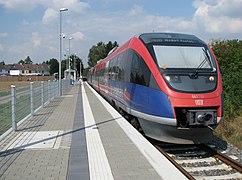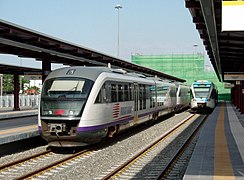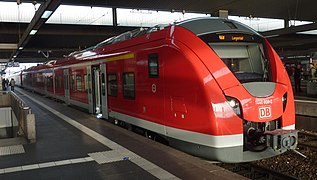
A diesel multiple unit or DMU is a multiple-unit train powered by on-board diesel engines. A DMU requires no separate locomotive, as the engines are incorporated into one or more of the carriages. Diesel-powered single-unit railcars are also generally classed as DMUs. Diesel-powered units may be further classified by their transmission type: diesel–mechanical DMMU, diesel–hydraulic DHMU, or diesel–electric DEMU.

The Siemens Desiro is a family of diesel or electric multiple unit passenger trains developed by Siemens Mobility, a division of the German Siemens AG conglomerate. The main variants are the Desiro Classic, Desiro ML, Desiro UK and the later Desiro City, Desiro HC and Desiro RUS. The trains are mostly used for commuter and regional services, and their rapid acceleration makes them suitable for services with short distances between stations. The design is flexible, and has become common in many European countries.

A bumper is a structure attached to or integrated with the front and rear ends of a motor vehicle, to absorb impact in a minor collision, ideally minimizing repair costs. Stiff metal bumpers appeared on automobiles as early as 1904 that had a mainly ornamental function. Numerous developments, improvements in materials and technologies, as well as greater focus on functionality for protecting vehicle components and improving safety have changed bumpers over the years. Bumpers ideally minimize height mismatches between vehicles and protect pedestrians from injury. Regulatory measures have been enacted to reduce vehicle repair costs and, more recently, impact on pedestrians.

The International Union of Railways is an international rail transport industry body.

The European Train Control System (ETCS) is a train protection system designed to replace the many incompatible systems used by European railways, and railways outside of Europe. ETCS is the signalling and control component of the European Rail Traffic Management System (ERTMS).

A side collision is a vehicle crash where the side of one or more vehicles is impacted. These crashes typically occur at intersections, in parking lots, and when two vehicles pass on a multi-lane roadway.

PKP Intercity is a company of the PKP Group responsible for long-distance passenger transport. It runs about 350 trains daily, connecting mainly large agglomerations and smaller towns in Poland. The company also provides most international trains to and from Poland. Trains offer Wi-Fi connectivity.
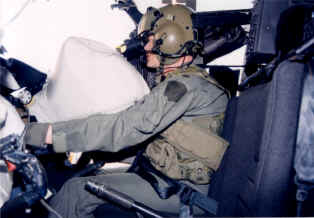
Crashworthiness is the ability of a structure to protect its occupants during an impact. This is commonly tested when investigating the safety of aircraft and vehicles. Different criteria are used to figure out how safe a structure is in a crash, depending on the type of impact and the vehicle involved. Crashworthiness may be assessed either prospectively, using computer models or experiments, or retrospectively, by analyzing crash outcomes. Several criteria are used to assess crashworthiness prospectively, including the deformation patterns of the vehicle structure, the acceleration experienced by the vehicle during an impact, and the probability of injury predicted by human body models. Injury probability is defined using criteria, which are mechanical parameters that correlate with injury risk. A common injury criterion is the head impact criterion (HIC). Crashworthiness is measured after the fact by looking at injury risk in real-world crashes. Often, regression or other statistical methods are used to account for the many other factors that can affect the outcome of a crash.
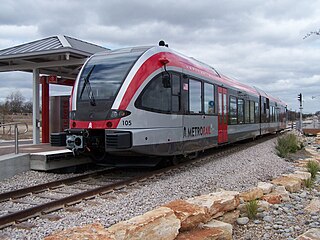
The Stadler GTW is an articulated railcar for local transport made by Stadler Rail of Switzerland. GTW stands for Gelenktriebwagen.

In a railway accident, telescoping occurs when the underframe of one vehicle overrides that of another, and smashes through the second vehicle's body. The term is derived from the resulting appearance of the two vehicle bodies: the body of one vehicle may appear to be slid inside the other like the tubes of a collapsible telescope – the body sides, roof and underframe of the latter vehicle being forced apart from each other.
The European Rail Traffic Management System (ERTMS) is the system of standards for management and interoperation of signalling for railways by the European Union (EU). It is conducted by the European Union Agency for Railways (ERA) and is the organisational umbrella for the separately managed parts of
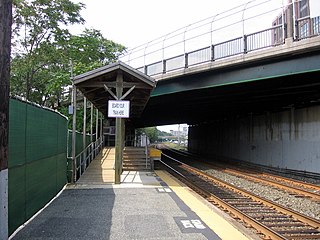
Railway platform height is the built height – above top of rail (ATR) – of passenger platforms at stations. A connected term is train floor height, which refers to the ATR height of the floor of rail vehicles. Worldwide, there are many, frequently incompatible, standards for platform heights and train floor heights. Where raised platforms are in use, train widths must also be compatible, in order to avoid both large gaps between platforms and trains and mechanical interference liable to cause equipment damage.
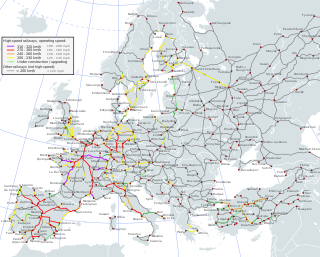
The Trans-European high-speed rail network (TEN-R), together with the Trans-European conventional rail network, make up the Trans-European Rail network, which in turn is one of a number of the European Union's Trans-European transport networks (TEN-T). It was defined by the Council Directive 96/48/EC of 23 July 1996.
A Technical Specification for Interoperability is a text provided for in European Directive 2016/797 adopted by the European Parliament and the Council of the European Union on the interoperability of the European rail system in accordance with the ordinary legislative procedure.

The Rail Vehicle Accessibility Regulations 2010 is a statutory instrument in the United Kingdom. It aims to set standards designed to improve accessibility for disabled people on light rail passenger vehicles.

The Frecciarossa 1000, is a high-speed train operated by Italian state railway operator Trenitalia and the private Spanish high-speed rail operator Iryo. It was co-developed as a joint venture between Italian rail manufacturer Hitachi Rail Italy and multinational conglomerate Alstom. Both design and production work were divided between the two partner companies.

The RABe 501, nicknamed Giruno, is a high-speed electric multiple unit train built by Stadler Rail of Switzerland for the Swiss Federal Railways (SBB). According to Stadler Rail, it was the world's first single-decker low-floor high-speed train.

The European Union Agency for Railways (ERA) is an agency of the European Union (EU) that sets mandatory requirements for European railways and manufacturers in the form of Technical Specifications for Interoperability (TSI), which apply to the Trans-European Rail system. The ERA publishes a document summarising the status of the TSIs. The ERA sets common safety targets, common safety methods and common safety indicators, following Directive 2004/49/EC and amendments. The ERA also hosts a number of databases, among which a register of remaining, applicable national rules.
EuroSpec, abbreviation for European Specification for Railway Vehicles, is an initiative of several European railway companies with the aim to develop common, explicit technical specifications for train systems and components. The work program includes doors, parking noise, TCMS, seating comfort and the revision of published specifications. The jointly developed specifications support and facilitate the process of purchasing trains. These specifications are not in the competitive domain. The continued application of the EuroSpec methodology and the developed specifications support the standardisation of trains and lead to higher quality, support the development of vehicle platforms and provide significant cost savings. As a basis for developing their specifications, EuroSpec partners have developed a "Requirement Management" manual to ensure the necessary consistency between the specifications and their quality. The work started in 2011.
The functional requirements for rail vehicles of the EuroSpec specifications are used in procurement in addition to the technical specifications for interoperability, the EN standards and the national notified technical rules (NNTR).
The EuroSpec consortium does not prepare "European Standards" or "International Standards" within the meaning of Regulation (EU) No 1025/2012 of the European Parliament and of the Council of 25 October 2012. EuroSpec specifications should therefore be classified as a "technical specification". They are increasingly used as input for European Standards and Regulations.



